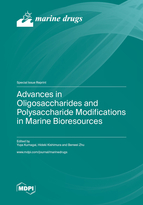Advances in Oligosaccharides and Polysaccharide Modifications in Marine Bioresources
A special issue of Marine Drugs (ISSN 1660-3397).
Deadline for manuscript submissions: closed (31 January 2023) | Viewed by 26814
Special Issue Editors
Interests: enzymatic character of marine organisms and microorganisms; exploitation of utilization of marine algae; development of genome editing method for marine algae
Special Issues, Collections and Topics in MDPI journals
Interests: red algae; marine invertebrates; phycoerythrin; xyloorigosaccharide; marine enzymes; marine collagen; chloroplast DNA; antihypertension; prebiotics; antioxidation; antidiabetes
Special Issues, Collections and Topics in MDPI journals
Interests: discovering, enzymatic and structural characterization; novel marine polysaccharide-degrading enzymes
Special Issues, Collections and Topics in MDPI journals
Special Issue Information
Dear Colleagues,
Due to global climate change, environmental issues have become more conscious. Seaweeds play a major role in blue carbon, which fixes carbon to the ocean by taking in carbon dioxide through photosynthesis and producing polysaccharides. In addition to environmental problems, marine polysaccharides have various modifying groups and have been found to have different functionality from land plants. Marine polysaccharides have been used in foods and medicines. Recently, novel biocatalysis of polysaccharide-relating enzymes has been discovered. As a result, the functionality of oligosaccharides from marine polysaccharides has been clarified, e.g., health functionality such as anti-cancer, anti-inflammatory effect, intestinal regulation and antioxidant activity. This Special Issue aims to accumulate the knowledge of preparation, function, structure, and application of bioactive oligosaccharides and polysaccharides-relating enzymes from marine organisms. This Special Issue aims to contribute to the achievement of multiple goals of Sustainable Development Goals (SDGs) (No. 2, 3, 12, 14), and we would like to invite scientists to submit their latest research findings in this field. Comprehensive review papers are also welcome.
Dr. Yuya Kumagai
Prof. Dr. Hideki Kishimura
Dr. Benwei Zhu
Guest Editors
Manuscript Submission Information
Manuscripts should be submitted online at www.mdpi.com by registering and logging in to this website. Once you are registered, click here to go to the submission form. Manuscripts can be submitted until the deadline. All submissions that pass pre-check are peer-reviewed. Accepted papers will be published continuously in the journal (as soon as accepted) and will be listed together on the special issue website. Research articles, review articles as well as short communications are invited. For planned papers, a title and short abstract (about 100 words) can be sent to the Editorial Office for announcement on this website.
Submitted manuscripts should not have been published previously, nor be under consideration for publication elsewhere (except conference proceedings papers). All manuscripts are thoroughly refereed through a single-blind peer-review process. A guide for authors and other relevant information for submission of manuscripts is available on the Instructions for Authors page. Marine Drugs is an international peer-reviewed open access monthly journal published by MDPI.
Please visit the Instructions for Authors page before submitting a manuscript. The Article Processing Charge (APC) for publication in this open access journal is 2900 CHF (Swiss Francs). Submitted papers should be well formatted and use good English. Authors may use MDPI's English editing service prior to publication or during author revisions.
Keywords
- marine biotechnology
- marine organism
- enzyme kinetics
- crystal structure
- biocatalysis
- polysaccharide
- carbohydrate recognition









